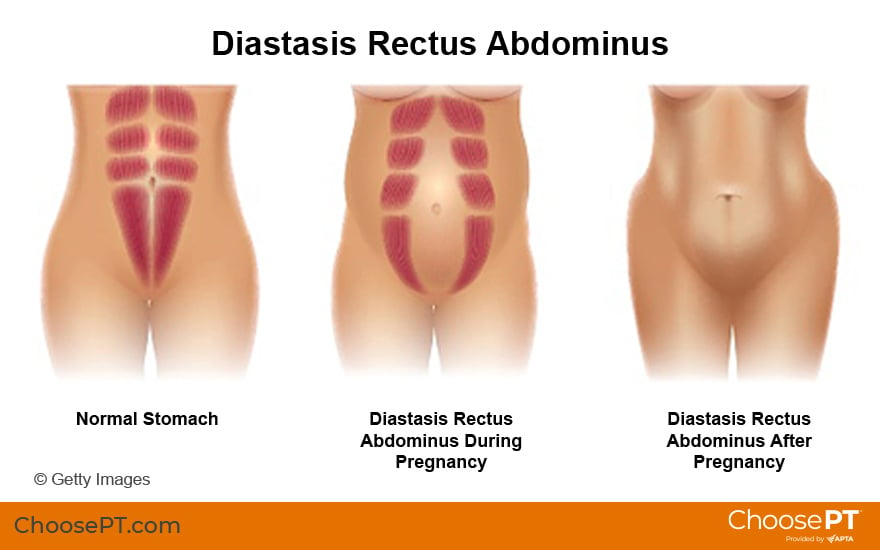Physical Therapy Guide to Diastasis Rectus Abdominis
Diastasis rectus abdominis is a separation of the left and right sides of the outermost abdominal (stomach) muscle. It is caused by forces that stretch the connective tissue called the linea alba. This condition most often occurs in pregnancy, but also may occur in infants, older women, and men. Physical therapists help adults with DRA manage their symptoms, improve their strength and stamina, and safely return to their regular activities. DRA is fairly common in infancy. For babies with DRA care and monitoring is provided by a pediatrician.
Physical therapists are movement experts. They improve quality of life through hands-on care, patient education, and prescribed movement. You can contact a physical therapist directly for an evaluation. To find a physical therapist in your area, visit Find a PT.
What Is Diastasis Rectus Abdominis?

The most common cause of DRA is pregnancy. As the fetus grows, the uterus expands and increases pressure against the stomach wall. This pressure causes the connective tissue to widen, increasing space between the right and left sides of the muscle. It may be noticed during or after pregnancy. Typically, DRA develops during the second or third trimester when the fetus grows most rapidly. DRA often resolves on its own during the first three months after the birth (postpartum). Other potential causes for DRA include:
- Frequent or rapid changes in weight.
- Stomach obesity.
- Genetics.
- Poor training technique or overloading the stomach wall during heavy lifting activities.
Infants commonly are born with a DRA that resolves over time without treatment. Pediatric doctors may monitor infants for the development of an umbilical hernia.
Several factors may make a person more prone to developing DRA. These include age, being pregnant with multiple children, and having had many pregnancies. The stomach muscles have many important functions within the body. These muscles aid in postural support, movement, breathing, and protection of the internal organs. For some people, a DRA may:
- Persist after pregnancy.
- Change the appearance of the stomach muscles.
- Result in reduced muscle strength.
For someone juggling the normal stresses of a new baby, discomfort, weakness, and changes to postural control, the added muscle weakness from a DRA may impact quality of life.
How Does It Feel?
Separated stomach muscles are usually painless and often have no symptoms. Some people, however, report problems that may be related to DRA that can include:
- Appearance.
- Discomfort.
- Difficulty doing certain activities.
A person with DRA may experience any of the following symptoms:
- A separation of the rectus abdominis muscle that is visible and felt by touching the stomach.
- Feelings of "flabbiness" in the stomach muscles.
- Low back, pelvic, or hip pain.
- Poor trunk posture.
- Feeling weak through the midsection.
- Doming or tenting of the middle of the stomach. This can occur during activities such as lifting, rolling over in bed, or certain exercises.
How Is It Diagnosed?
Your physical therapist will review your medical history and conduct a thorough interview. For women, this may include specific questions about:
- Pregnancies.
- Labor and delivery history.
- Type of delivery (cesarean or vaginal).
- Pain.
- Activities that make your symptoms better or worse.
- History of abdominal organ illness or surgeries.
- Types and level of physical demands at work, home, and sport.
Your physical therapist also will ask you when your symptoms began and how they impact your daily life.
They will gently feel your stomach muscle (palpate) to find if it has separated. Your physical therapist also will assess factors that can influence your strength, mobility, and endurance. These factors can include your:
- Posture.
- Breathing.
- Flexibility.
- Overall muscle strength.
- Movement patterns during certain activities.
How Can a Physical Therapist Help?
Physical therapy is a very effective way to manage the symptoms of DRA. It can improve your strength and stamina so you can return to normal activities. Your physical therapist may help you with:
Education. Your physical therapist can identify which movements or activities to modify or avoid as you recover. They will help you safely progress your activities as you heal. Your physical therapist will teach you safe and effective ways to regain your full function, so you can return to the activities that you enjoy.
Postural training. Learning to engage the deep core muscles through posture and breathing is one of the most important parts of treatment for people with DRA. This involves posture training and breathing to activate your deep core muscles as a unit. Postural training will focus on the:
- Transverse abdominis muscles.
- Diaphragm.
- Low back muscles.
- Pelvic floor muscles.
Your physical therapist will show you ways to do daily activities, such as lifting and carrying a baby or other objects. These methods will help to strengthen and reduce pressure on your stomach muscles
Exercise training. There are four layers of stomach muscles, and all are important in DRA rehabilitation. These muscles are the:
- Transverse abdominis.
- Internal and external obliques.
- Rectus abdominis.
A physical therapist can teach you the right type and intensity of exercises for your condition and goals. They can help you progress through them as you get stronger. Your physical therapist can address muscle imbalances. They also can show you stretches and diaphragm releases to help restore normal breathing patterns.
Bracing. Taping or braces for the abdominal region can provide support for some women with DRA during pregnancy. Your physical therapist also may recommend the use of support in the early phases of recovery. Support garments put the abdominal muscles in a more normal position. The tape or brace may remind you to safely use your core muscles during activities that increase pressure on the stomach. A brace or tape does not make your muscles weaker. Physical therapists treating pregnant women can make sure a support brace or garment is right for use during pregnancy.
Electrical muscle stimulation. This treatment may be used by a physical therapist to reduce DRA. It is used after pregnancy and in other adult populations. Electrical muscle stimulation gently activates the rectus abdominis muscle. It has been shown to improve function and reduce the amount of separation.
Can This Injury or Condition Be Prevented?
DRA is a natural consequence of pregnancy. In most cases it resolves on its own and does not impair function. Studies show that starting a program to stabilize the core and pelvic-floor muscles in early pregnancy is highly effective. It can improve function and help you manage the pressure that may worsen a DRA during and after pregnancy. A physical therapist can help women learn safe and effective exercise strategies to improve their:
- Pregnancy.
- Labor.
- Delivery.
- Experience after giving birth.
Physical therapy strategies to manage abdominal pressure during work activities and a personalized program of safe, progressive exercise also are effective for men and women with non-pregnancy-related DRA. If you develop DRA, the earlier you see a physical therapist, the faster you will be able to return to the activities you enjoy.
What Kind of Physical Therapist Do I Need?
All physical therapists are prepared through education and experience to identify and treat diastasis rectus abdominis. However, you may want to consider:
- A physical therapist who has experience working with people who have diastasis rectus abdominis. Some physical therapists have a practice with a pelvic or women’s health physical therapy focus.
- A physical therapist who is a board-certified clinical specialist in women’s health physical therapy (with a WCS credential) or who has completed advanced education in obstetrics physical therapy offered through the Academy of Pelvic Health (CAPP-OB), or who completed a residency or fellowship in women’s health physical therapy. These physical therapists have advanced knowledge, experience, and skills in pregnancy and postpartum rehabilitation and have the training credentials to treat both men and women with DRA.
You can find physical therapists who have these and other credentials by using Find a PT, the online tool built by the American Physical Therapy Association to help you search for physical therapists with specific clinical expertise in your geographic area.
General tips when you’re looking for a physical therapist (or any other health care provider):
- Get recommendations from family, friends, or other health care providers.
- When you contact a physical therapy clinic for an appointment, ask about the physical therapists’ experience helping people with diastasis rectus abdominis.
- Be prepared to describe your symptoms in as much detail as possible.
The American Physical Therapy Association believes that consumers should have access to information that could help them make health care decisions, and also prepare them for a visit with their health care provider.
The following articles provide some of the best scientific evidence related to physical therapy treatment of diastasis rectus abdominis. The articles report recent research and give an overview of the standards of practice both in the United States and internationally. The article titles are linked either to a PubMed* abstract of the article or to free full text so that you can read it or print out a copy to bring with you to your health care provider.
Thabet AA, Alshehri MA. Efficacy of deep core stability exercise program in postpartum women with diastasis recti abdominis: a randomised controlled trial. J Musculoskelet Neuronal Interact. 2019;19(1):62. Article Summary on PubMed.
Hills NF, Graham RB, McLean L. Comparison of trunk muscle function between women with and without diastasis recti abdominis at 1 year postpartum. Phys Ther. 2018;98(10):891–901. Article Summary on PubMed.
Keshwani N, Mathur S, McLean L. Relationship between interrectus distance and symptom severity in women with diastasis recti abdominis in the early postpartum period. Phys Ther. 2018;98(3):182–190. Article Summary on PubMed.
Kamel DM, Yousif AM. Neuromuscular electrical stimulation and strength recovery of postnatal diastasis recti abdominis muscles. Ann Rehabil Med. 2017;41(3):465. Article Summary on PubMed.
Benjamin DR, van de Water AT, Peiris CL. Effects of exercise on diastasis of the rectus abdominis muscle in the antenatal and postnatal periods: a systematic review. Physiotherapy. 2014;100(1):1–8. Article Summary on PubMed.
Sharma G, Lobo T, Keller L. Postnatal exercise can reverse diastasis recti. Obstet Gynecol. 2014;123 Suppl 1:171S.
Barbosa S, de Sa RA, Coca Velarde LG. Diastasis of rectus abdominis in the immediate puerperium: correlation between imaging diagnosis and clinical examination. Arch Gynecol Obstet. 2013;288(2):299–303. Article Summary on PubMed.
Expert Review:
Sep 10, 2020
Revised:
Sep 10, 2020
Content Type: Guide
Diastasis Rectus Abdominis
Karen Litos
PT, DPT, board-certified clinical specialist in women’s health physical therapy
Sandi Gallagher
PT, DPT, board-certified clinical specialist in women’s health physical therapy, on behalf of APTA Pelvic Health, an academy of the American Physical Therapy Association
You Might Also Like...
Health Tips
Pregnancy Pains: Causes, Solutions, and Comprehensive ReliefJun 17, 2024
Pregnancy can be an exciting and joyous experience. It also can come with discomfort and health concerns. Learn about the causes of pain during pregnancy
Health Tips
From Pregnancy to Menopause: 4 Ways Physical Therapy Advances Women’s HealthApr 15, 2024
Physical therapy isn't only for rehabilitation from sports injuries or recovering after surgery? Physical therapists also play an important role in women's
Health Tips
5 Tips for Physical Activity After ChildbirthMar 12, 2021
After having a baby, you might want to get back into shape quickly. But it is important to make a slow return to full activity with tips from physical


